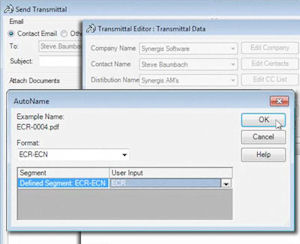Check it Out: Watch Creating a Transmittal in Adept Product Data Management
Latest News
December 4, 2001
By Anthony J. Lockwood
Watch: Creating a Transmittal in Adept Product Data Management |
Dear Desktop Engineering Reader:
Did I ever tell you that, 30 or so years ago, part of my job was to explain what e-mail was? No one could imagine any use for it. They were right. See, we were developing the first online conferencing system from a major publisher. Its e-mail was isolated from the rest of the world for a variety of technical reasons, such as being BIE (Before Internet Era). Since we couldn’t e-mail headquarters, out of house, or even to most departments in our business, we sent documents through interoffice and snail mail. I, for one, spent a lot of time and notebook paper manually tracking the documents I sent to my corporate masters. Imagine if you could not reliably send and track files in-house or with third-parties today.
Oh, wait a minute. Maybe you can’t. If you control and manage your data on a PDM (product data management) system, you can find that assembling, sending, and tracking project data with colleagues not on the system or outside your building a flashback to days of yore.
While it’s fine and dandy to make a copy of something, dump it on a shared drive, then drop the interested parties an e-mail, how do you create an audit trail of the documents? Three weeks from now, how do you find the version number or the date you sent a file to the BIG client who says that you never sent it? Rummage manually through your outbox then look up what version was current on that date and time, I suppose.
The Adept PDM system from Synergis Software has this nifty toolset called Transmittal Automation that tackles this. The feature leverages customizable forms and cover sheets. What it does for you is let you select the document to send from inside of Adept and tell Adept where it’s going – the boss, distribution lists, internal, external, the big client, you get it. It can automatically convert the document to PDF or zip it up with other data. Transmittal Automation then e-mails the file to your contacts, or it can also post to an FTP site and send your contacts the link.
The key is that the Transmittal Automation feature establishes and maintains a searchable relationship between your transmittal cover sheet and the documents you sent. This creates an audit trail showing your activities related to the document transmitted. And that means such things as which version of what document was sent to whom on what date are at your fingertips.
As you may guess, within the Adept environment and among Adept users – as opposed to non-Adept third-parties – the Transmittal Automation feature ties into more tools and functionalities, say approvals, that can have dramatic impact on your workflows. But even if you’re just sending documents out of house, the way you assemble your data, route it, and create an audit trail makes Transmittal Automation a time-saving and aggravation-elimination tool that you’re likely to rely on.
Today’s Check It Out link over there takes you to a 4-minute video demonstration showing how the Transmittal Automation feature operates. My impression, and I am not an Adept user, is that this is a logical, intuitive, and a useful tool that I wished I had at my disposal. Give it a look and see for yourself.
Thanks, Pal. — Lockwood
Anthony J. Lockwood
Editor at Large, Desktop Engineering
Subscribe to our FREE magazine, FREE email newsletters or both!
Latest News
About the Author
Anthony J. Lockwood is Digital Engineering’s founding editor. He is now retired. Contact him via [email protected].
Follow DE






